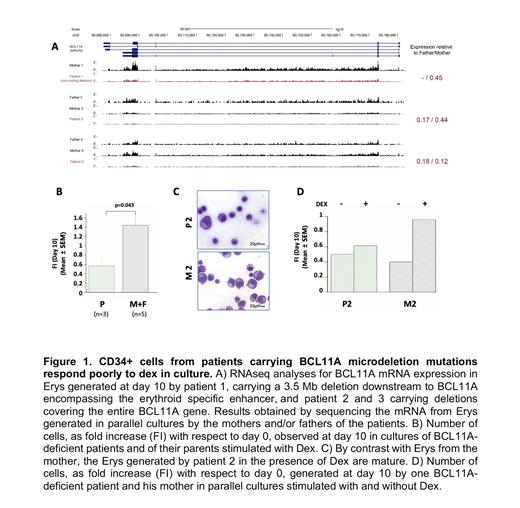Abstract
Extrapolations from data in mouse models and from human erythroid cells expanded ex vivo with the glucocorticoid receptor (GR) agonist Dexamethasone (Dex), suggest that GR plays an important role in the regulation of stress erythropoiesis 1. However, the mechanistic details of stress erythropoiesis are still poorly understood.
By exploring the effects of Dex on erythroid expansion of CD34+ cells from a large number of healthy adult donors (n=25), we documented that Dex expands a population of immature erythroid cells which express high levels of BCL11A. In addition, in these cells BCL11A is mostly in the nuclei, compared to cells grown without Dex. These results suggest that GR regulates the transcriptional activity of BCL11A.
To validate the role of BCL11A in the Dex response, we made observations in cells from patients with BCL11A deficiencies 2. We found that BCL11A-deficient CD34+ cells generate lower numbers of maturing erythroid cells compared to controls with Dex addition, suggesting that they respond poorly to Dex (Fig 1). Of note, RNAseq analyses indicate that erythroid cells expanded from the patients express levels of BCL11A lower than that of their parent cells while the levels of expression of other genes known to mediate the response to Dex of erythroid cells (ZFP36L2, CDKNIC and PPARA 3-5) expressed by these cells is normal.
Further we extended our observations to Cushing's patients with highier cortisol levels, before(V1) and after their treatment(V2) using concurrent age and weight matched healthy controls (MC). There is no significant difference in frequency of CD34+ cells among V1, V2 and MC (range 0.3-2% in all cases). CD34 pos cells from all groups express similar levels of cKIT, IL-3Rβ, CXCR4 and CALR. However, a greater proportion of CD34+ cells from V1 express CD36 and CD110 (the thrombospondin and thrombopoietin receptor) and CD133 (the hematopoietic stem cell marker prominin) than those from V2 and MC (60-80% vs 10-20%), suggesting that the circulating progenitor cells from active Cushing's patients are a unique population likely generated in response to their high cortisol levels given that the phenotype of CD34+ cells from the blood of V2 patients is similar to that found in MC. The phenotype of CD34+ cells from Cushing's patients in vivo is similar to that of CD34+ cells generated in vitro after 2-4 days of culture with Dex 3,6,7. V1 progenitor cells generate similarly large number of immature erythroid cells in culture with and without Dex. By contrast with normal cells, these active cells also express lower levels of the cytoplasm-restricted form of GRα (GRS203) and greater levels of GILZ and BCL11A than normal or V2 cells.
In conclusion, the data presented here indicate that GR activation switches the erythroid differentiation program from the steady-state to the stress mode and that activation of BCL11A is part of the response of erythroid cells to Dex.
References
1) Varricchio et al Am J Blood Res. 2014;4:53; 2) Funnell et al Blood 2015; 126:89; 3) Ashley et al JCI 2020;130:2097; 4) Zhang L et al Nature 2013;499:92; 5) Lee et al Nature 2015;522:474; 6) Heideveld et al Haematologica 2015; 100:1396; 7) Xiang et al Blood 2015;125:1803.
Migliaccio: Dompe farmaceutici Spa R&D: Other: received funding for reserach .


This feature is available to Subscribers Only
Sign In or Create an Account Close Modal